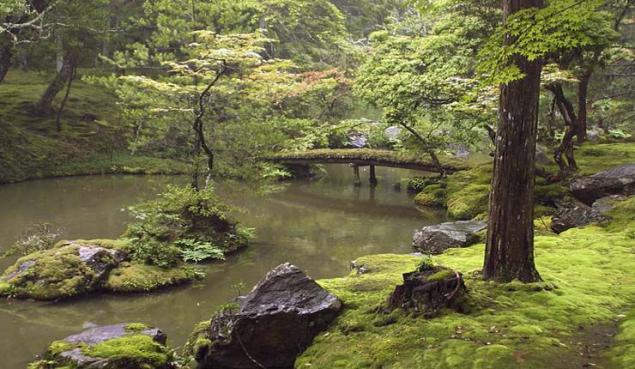Japanese rock garden
 Bashny.Net
Bashny.Net

The Chinese word "landscape" is composed of two characters: shan - Mount and Shui - water. Mountain represents the principle of yang - light, hard, strong, looking; and the water - the principle of yin - dark, deep, soft, passive. That is landscape embodies the basic concepts of ancient philosophy. This philosophy is deeply rooted in the Japanese consciousness, and with the principles of Buddhism, Taoism and Shinto forms the context of culture.
In Japanese gardens guidance on the device you will not find a strictly fixed rules rather many variations. Creating a garden in the Japanese style requires a lot of skill, experience, knowledge and a strong imagination. What you do not choose garden - hilly (Tsukiyama), flat (hiraniva), with a pond (SENS), garden, moss-covered (kokeniva) - before planning a garden on the ground, you have to fold it in "head».
The backbone of the garden form stones. By the stones must be treated as living creatures of nature. Need to feel the language spoken by each stone, to understand its plastic possibilities. There is no "just" a stone in Japanese every stone has its own name, depending on the origin, breed and position it will occupy in the garden.
Do not look for the ideal proportions, but comprehend the inner reality. Then stones like pearls, are bound together by an invisible thread. Do not get carried away with realistic details, but feel the rhythm and movement of life in the garden. The garden should live by the laws of the "four seasons", match the mood season.
One of the most important features of the Japanese garden - "openness", unfinished garden, which can be extended. Often emphasized the principle of asymmetry, the "wrong". But this is only the external, visual symptoms.
Japanese garden design does not rely on visual tricks, not on the three-dimensional structures, and dynamic connection of both. Achieving harmony are also the intervals between elements of the landscape and shape the spaces between them. The number of elements must be readily accessible to perception. Japanese choose the smallest possible number of elements, usually 3-5-7. They say a lot with few resources. In ancient times, the number of 3-5-7 had a sacred meaning, in addition, they are objectively create a sense of balance and harmony.
Texture and method of laying varied depending on the prevailing style at this time. In the Momoyama period (late XVI - early XVII century) was a popular story of the Chinese Song Dynasty painting - two rocks, waterfall between them, the stone bridge.
According to Buddhism, in the center of the world is Mount Sumeru, around nine vertices and eight seas. This story was reproduced in creating rock gardens. A common arrangement of three stones symbolize the Buddhist triad. One stone large, two smaller ones, each has its own name.
Mountain Choir in Taoism is the seat of reaching immortality Taoists. In the Japanese garden symbolizes the mountain choir island in the pond. A small cave in the garden of stones symbolizes mountain abode of spirits. A few flat stones in a pond lined up, to depict Japanese tradition fishing schooner. Very popular gems - the island, called "Crane" and "turtle", meaning longevity.
The composition of the two stones laid in a northeasterly direction, and one stone lies in the shadow of another - an allegory of the relationship of man and woman. Rocks in the waterfall portrayed carp fighting over. Waterfall is the habitat of the dragon, which is considered a good spirit and patron. This is only a small part of the symbols used by the master when creating a garden.
As we have said, rocks and water must be in harmonic interaction. Water can be both real and imaginary, then it symbolizes the white sand or gravel with painted "waves". In the tea gardens has a tradition of wetting the surface of the track before the ceremony. Tea garden called - Rhodes - "land covered with dew." The tea garden is also worth a stone bowl for ritual ablutions. If the stones - the backbone of the garden, the water - his flesh, mobile, changeable, elusive.
Tags
See also
Not uniform stones. Moss garden in Kyoto
Energy gymnastics hand from Yoshiro Tsutsumi
How to install and group the stones in the rockeries
Stone Garden in Chandigarh
Rockeries
Ho Chi Minh city — Japanese garden in Vietnam
Gorgeous Japanese garden in Vietnam
Miracle flower Park
Park and glass colors in Montreal
















